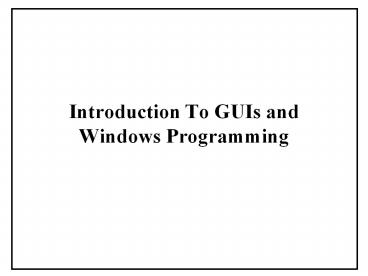Introduction To GUIs and Windows Programming - PowerPoint PPT Presentation
1 / 20
Title:
Introduction To GUIs and Windows Programming
Description:
Introduction To GUIs and. Windows Programming. User Interfaces ... Main Feature of GUIs: THE WINDOW. Rectangular area of screen onto which a ... – PowerPoint PPT presentation
Number of Views:1192
Avg rating:3.0/5.0
Title: Introduction To GUIs and Windows Programming
1
Introduction To GUIs andWindows Programming
2
User Interfaces
- Connection between the computer and the user
- Two types
- Command Line
- GUI--Graphical (Visual)
3
Command Line Interfaces
- User types commands gt must remember
- Results Scroll by
- Text-based
- Interactive but hard to use
- No direct interaction between user and screen
4
Visual (Graphical) Interfaces
- Show Graphical Objects on screen
- e.g., images, icons, buttons, scroll bars
- User interacts using pointing device
- Intuitive
- Objects can be dragged, buttons pushed, etc....
- Better way of using screen space
- Panes can overlap
- Underlying panes can be brought to forefront
- Desktop metaphor (like papers on a desk)
- Well, not exactly!
5
Graphical Interfaces (Contd)
- Use graphics to organize user workspace
- Environment allows many tasks to be performed
simultaneously - Different tasks share screen space
- Visually rich way of conveying information
- WYSIWYG display of documents
6
Main Feature of GUIs
- THE WINDOW
- Rectangular area of screen onto which a
- program draws text and graphics.
- User interacts with program using pointer
- device to select objects inside.
- Some window components
- border, title bar, client area, menu bar, scroll
bars, max/min/close buttons, tool bars, etc.
7
GUI-Windowing Systems
- Microsoft Windows
- JAVA AWT , Swing
- X Window
8
Windowing Systems Features
- Consistent user interface
- Multitasking
9
Consistent User Interface
- Display within a window
- Menus to initiate program functions
- Make use of child window controls
- predefined windows used with main program window
- examples buttons, scroll bars, edit controls,
list boxes, drop-down list boxes, comboboxes - Dialog box--popup window containing several
controls
10
Consistent User Interface (contd)
- Programs have same look and feel
- Same built-in logic to
- draw text/graphics
- display menus
- receive user input
- controls, dialog boxes, use of mouse
11
Multitasking
- Every program acts like a RAM-resident popup
- Programs run simultaneously
- Each program occupies its own window
- User interacts with program in its window
- User can switch between programs
12
Windows Multitasking Features
- Cooperative (Windows 3.xx)
- Programs give up control so others can run
- Programs coexist with other programs
- Preemptive (Windows NT, 95, 98)
- Thread-based System timer allocates time slices
to running program threads - Under both systems, code is moved or swapped into
and out of memory as needed
13
Windows Memory Management
- Older versions 16-bit, segmented memory
- Dictated by processor architecture
- Hard to program
- Newer versions 32-bit, flat memory model
- Easier to program
- As old programs terminate, new ones start
- Code swapped into and out of memory
- Fragmentation can occur
- Windows must consolidate memory space
- Moves blocks of code/data continually
- Programs can share code located in other files
(Dynamic linking)
14
Static vs. Dynamic Linking
- Static Linking
- code incorporated into executable at link time
- Dynamic Linking
- Code is put into separate modules
- These are loaded at run time
- Linker generates relocation information
- Only that is put into executable
- Smaller programs
- DLL loaded when needed
- Relocation info used to get DLL function code as
needed
15
(No Transcript)
16
(No Transcript)
17
Device Independent GraphicsInterface
- Windows programs dont access hardware devices
directly - Make calls to generic functions within the
Windows Graphics Device Interface (GDI) - The GDI translates these into HW commands
18
Device Independent GraphicsInterface
- May use device drivers (HW control programs)
- Thus graphics I/O done in a standard way
- Programs will run unaltered on other HW platforms
19
Windows API
- The interface between an application and Windows
Operating systems - A library of functions Windows programs can call
- Several versions
- Win16 (16 bit apps for Windows 3.xx)
- Win32 (32 bit apps for Windows NT/95)
- Win32s (patches Win16 to create 32 bit apps that
run under Windows 3.xx)
20
Classical Win32 API Windowsprogramming
- Use C to access raw API functions directly
- Hard way to go, but most basic
- Faster executables
- Provides understanding of how Windows and
application program interact - Establishes a firm foundation for MFC
programming
21
Sequential Programming(Console Apps)
- Standard programming--program solicits
- input (polling loop)
- Approach follows a structured sequence of
- events
- Example--averaging grades
- Input name
- Input first grade
- Input second grade
- Input third grade, etc.
- Calculate average
- Output average
22
Event-Driven Programming
- Designed to avoid limitations of sequential,
procedure-driven methodologies - Process user actions (events) as they happen
non-sequential - Program doesnt solicit input
- OS detects an event has happened (e.g., theres
input) and sends a message to the program - Program then acts on the message
- Messages can occur in any order
23
(No Transcript)
24
Sequential vs. Event-Driven Programming
- Standard Sequential programming
- Program does something user responds
- Program controls user (the tail wags the dog)
- Event-Driven Programming
- Used by Windows
- User does something and program responds
- User can act at any time
- User controls program (the dog wags the tail)
- OS really is in control (coordinates message
flow to different applications) - Good for apps with lots of user intervention































